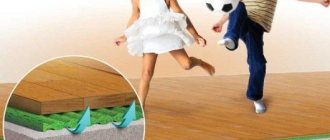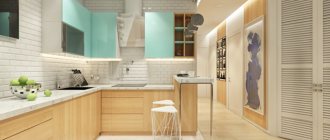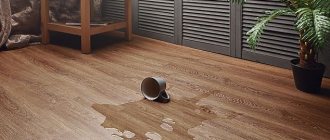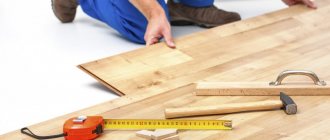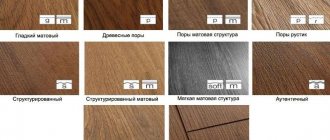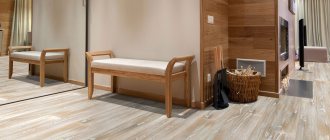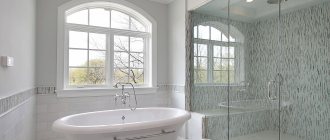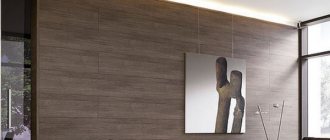When a serious renovation is underway in an apartment, the owner inevitably faces the question of choosing a floor covering, and most often this question is - which is better, parquet or laminate? Wood is the oldest building material; people have long appreciated its practicality, and over the last century they have begun to pay more and more attention to the environmental friendliness of wood. But before solving the dilemma, parquet or laminate - what to choose, of course, you need to understand the difference between their properties, compare the advantages and disadvantages.
Variety of types of wood flooring
Humanity has come up with quite a lot of floor coverings, the names of which contain the words “parquet” or “laminate”:
- laminated parquet;
- parquet board;
- laminate flooring, etc.
So that the ignorant buyer does not get confused in this variety, we will describe the main ones.
“Laminate flooring”, “laminated parquet” and simply “laminate” are the same thing.
And the variety in names is explained by the constant improvement of the manufacturing technology of this coating, the quality characteristics of which are constantly growing, and it itself looks more and more like natural parquet. That is, laminated parquet is the same laminate, but more reminiscent of natural dies.
As for parquet and parquet boards, these are completely different things:
- Classic parquet consists exclusively of hardwood. There are many types of parquet.
- Parquet boards appeared much later and are a material made from glued wooden planks in several layers. At the beginning, parquet boards were made from parquet production waste.
Design differences
A comparison of laminate and parquet should start with something common - both of these finishing materials are made of wood, and the parquet consists entirely of it.
Here lies the main difference between parquet and laminate, since in the manufacture of the latter, other materials are used along with wood.
Moreover, if European manufacturers' laminate consists of 90-95% wood, then Chinese products may contain no more than half of it.
Laminate is like a layered cake: the main layer is made of wood fiber, similar in structure to plywood or fiberboard, and the other layers are artificial materials - paper and resins. The front side of the laminate is made of very durable and wear-resistant plastic, which is used to laminate the product, hence its name. Under the layer of this transparent plastic there is also a film that has a pattern that imitates the texture of wood - it is this that determines the appearance of the laminate. The same technology is used to produce low pressure laminate.
Video about the differences in manufacturing and performance characteristics of parquet and laminate:
Laminate
Laminate is an artificial multi-layer material intended for organizing the finishing floor covering. It is supplied to the market in the form of small strips and lamellas, which are mounted together using locking connections.
- If we go through the entire structural pie of the laminate, then we will see polymer or waxed paper as the substrate. This is a protective layer. It protects the slats from moisture emanating from the subfloor.
- Next comes the fibreboard, depending on the manufacturer it will be fiberboard or chipboard. It is the basis of the entire coating. It is in it that locks are formed, on the strength and reliability of which the quality of the entire product depends.
- And again waterproofing. Moisture-sensitive wood fiber is fully protected in the laminate.
- The fourth layer is responsible for beauty. It is on this film that the manufacturer applies the desired pattern. Most often this is a wooden texture, but you can also see laminate like wild stone or the same marble, but such products are not very popular.
- And finally, the “icing” for this whole cake is melamine-formaldehyde or acrylic resin. A hard, wear-resistant product that protects this entire structure from dents, scratches and normal operating loads.
Have you assessed the complexity of the system? It looks like an ordinary laminated board.
But if you want to build a floor from these for your home or cottage, you should be aware of some of the disadvantages of such a product.
Fear of moisture
No matter how manufacturers assure you that their product is protected from moisture, no matter what kind of film or glue they use, remember! Laminate is afraid of water. If you look closely at the lamellas, you will find that the locking joints are completely defenseless; it is through them that the chipboard absorbs moisture.
Temperature expansions
When humidity and temperature change, laminate lamellas change their geometry. Several such movements and the seams become clearly visible. This is especially true for seamless products. Those with a smoothed edge retain their presentation much longer.
Noisiness
Judging by the reviews of the owners, one of the biggest sins of laminated flooring is its noise. Some types of expensive bedding are still capable of at least a little dampening the “rumble” coming from the laminate, but not as well as we would like. Still, with a density of 900 kg/m3 it is difficult to have good noise absorption.
Unnaturalness
Although laminate is positioned as a budget substitute for solid wood, it is still very far from the latter in terms of environmental friendliness. The slats of this product, no matter what they say, contain formaldehyde, very toxic substances that will certainly be released from it when the floor is heated. That is, everyone’s favorite heated floors and laminate are a very dangerous combination.
The safest product is considered to be one with emission class E0. The percentage of toxins there really approaches zero. Well, you can still purchase E1 class goods. We would not recommend anything above for your apartment.
Price
Listing the characteristics that demonstrate the difference between parquet and laminate, one cannot fail to note the price, which is several times higher for parquet than for any laminate.
The difference is significantly influenced by both the type of wood and the quality of the laminate. The most expensive brands of laminate are not much cheaper than parquet. But if the buyer already has enough money for an expensive laminate, then it is better to add a little more and buy parquet, which will have a number of advantages.
If the financial issue does not matter at all, then you definitely need to opt for a massive parquet board, or even better, block parquet.
Comparative characteristics of parquet boards and laminate
As can be seen from the characteristics given, both materials have their pros and cons relative to each other. So which option should you prefer? Which coating can be considered the best? Let's try to make a comparison and understand this issue.
Table of comparative characteristics of laminate and parquet boards:
| Technical characteristics of the coating | Parquet board | Laminate |
| Service life until the first visual signs of wear appear | up to 5 years | up to 3 years |
| Maximum wear resistance class | 31st grade | 34th grade |
| Need for additional processing | yes (impregnation of seams, application of protective mastic) | |
| Composition of the protective layer | resins and varnishes | acrylate and melamine resins |
| Protective layer thickness | up to 0.1 mm | |
| Coating weight, kg/m? | until 17 | to 10 |
| Moisture resistance | low | |
| Thermal insulation | average | |
| Scratch resistance | low | |
| Impact resistance | low | |
| Slip resistance level | short | average |
| Sound insulation level | short | |
| Color fastness level | short | average |
| Fragility level | average | |
| Hygienic requirements | norm | |
| Antistatic | does not accumulate static electricity | |
| Possibility of floor heating | yes (when using a foil backing and gluing the parquet to the floor) | yes (when using foil backing) |
Laminate or parquet board: which is better? Expert opinion on flooring installation
Laying both parquet boards and laminated panels requires certain preparation. However, based on the ease and simplicity of installation, experts give their vote in favor of the latter. Let's consider the features and differences in preparing the base in both cases.
The process of preparing the base for laying floor coverings:
- the existing floor must be filled with screed, having previously set the filling beacons to the zero level;
- when the screed is completely dry, you need to pour a self-leveling mixture on top, which will minimize even minor differences that will remain after the first stage;
- This is followed by the stage of laying the substrate. In the case of parquet boards, sheets of plywood are most often used, or they are completely dispensed with. But it will not be possible to lay laminate directly on concrete; high-quality flooring is needed here.
Parquet board in a children's room
Experts unanimously insist on the need to lay a high-quality substrate under the laminate. They come in a wide variety, and their choice is largely determined by what characteristics of the material are decisive for you. If you have to deal with the problem of sound insulation every day, then a cork backing will easily solve this issue. If the most pressing issue is reducing thermal conductivity, then a polyethylene foam substrate is what you need.
If we talk about the design of the “warm floor” system, then, according to experts, this can be done, but taking into account some nuances. This only refutes the myth that floor heating can only be done if tiles are laid on them.
Which is better, laminate or parquet boards: consumer reviews
Below are some reviews from owners of laminate and parquet floors.
“In the second year after laying the laminate, we accidentally spilled some wax from a burning candle on the floor. They tried to wipe it off right away, but while they were looking for something, it had already frozen. We were worried that we wouldn’t be able to quietly eliminate the consequences. But nothing, they carefully cleaned it off with a knife, and covered the remaining mark with a special pencil for laminate flooring. A year has passed and everything has gone unnoticed. In general, we are very pleased with the coating.”
Mikhail Novikov, Samara
For the kitchen it is better to choose moisture-resistant types of laminate
“We spent a long time choosing the covering for the living room, since it is a walk-through room and there are always a lot of people there. In the end, we decided to go with parquet. We were more than pleased with the coating. There are no difficulties in care. I use my grandmother’s method: I dilute 1 tbsp. a spoonful of vinegar in half a bucket of water and wash the floor with a regular mop. All contaminants are washed off perfectly.”
Irina Semakova, Naberezhnye Chelny
What is better for an apartment: laminate or parquet boards
Regardless of which of these options some consumers proclaim to be the best, there will always be those who disagree. And this is correct, because depending on personal preferences, certain qualities of each material may or may not be suitable in specific conditions. Generally speaking, both coatings are quite easy to install using a locking installation system. However, if we are talking about a room where there is very high traffic, for example, in a corridor, then it is better to give preference to laminate. It is less susceptible to rubbing and scratches, plus its level of impact resistance is several times higher than that of parquet.
Parquet board on the floor in the living room
But for all other criteria, it is better to choose parquet for decorating floors in an apartment. It can be easily restored after a certain period of time by sanding it and covering it with a new layer of varnish. This way you can easily get rid of all the scratches formed during use and return the coating to its original appearance. In addition, externally, parquet looks richer and more solid than laminate. The refined appearance of the wooden covering allows it to be used even in the most demanding and demanding interiors.
As for technical characteristics, such as thermal conductivity, parquet takes a leading place here too. Its ability to retain heat is higher, this is very important if the coating has to be laid directly on a concrete base. In the case of laminate, the problem of thermal conductivity can also be solved, but this costs additional effort and expense.
Among the difficulties of using parquet boards, it is worth noting that they are quite sensitive to changes in humidity in the room. In old houses, where there are no modern ventilation systems, due to changes in air humidity, the coating may swell and then shrink again. After the first such cycle, gaps will appear between the joints of the boards, and the parquet will begin to diverge.
There are two ways to solve this problem: installing an appropriate ventilation system and controlling air humidity, or choosing a laminate, which is much less sensitive to such changes.
Visually, the colors of the laminate are very similar to parquet boards
Parquet or laminate: which is better for a private home?
A wooden private house requires the use of natural wood materials in interior decoration. For example, if the house is built of timber, then the artificial laminated coating will look cheap and inappropriate. Brick or foam block houses are less demanding; a laminate that imitates oak or other wood species is perfect for laying on the floor.
If we talk about sound insulation, then laminate undoubtedly loses to parquet. But living in your own home, you can allow yourself to make as much noise as you like. So this problem is not relevant here. But if we are talking about renovations in an apartment, then before laying the laminate you will have to additionally acquire a soundproofing substrate. This is an additional hassle, but is worth the effort.
As for the financial side of the issue, laminate is definitely cheaper than parquet. Although you shouldn’t forget that you won’t be able to get by by purchasing panels alone. Among other things, you need to purchase a high-quality substrate and prepare a base for laying the coating.
The floor and steps in the room are decorated with parquet boards
Advantages and disadvantages of parquet and laminate
For the consumer, of course, there is no more important question than which material will perform better during operation.
Parquet
Advantages of parquet
- parquet can be restored many times;
- good thermal insulation makes parquet floors warm;
- good sound insulation;
- durability (with high-quality installation, material and adequate operating conditions, the service life of parquet will be tens of years);
- hypoallergenic;
- dust is not attracted to the wood.
Cons of parquet
- dents and scratches easily appear on the parquet;
- caring for parquet is troublesome and expensive - every few years it needs to be sanded and varnished, and this requires a special sanding tool and specialist skills;
- The procedure for restoring parquet is very lengthy (almost like a full renovation) and involves moving all the furniture.
- very sensitive to fluctuations in humidity and temperature, which causes it to dry out, crack or swell; high price.
Laminate
Advantages of laminate
- the operation of the laminate does not involve too much troublesome maintenance;
- with average intensity of use, laminate can last quite a long time - a couple of decades;
- the cost is cheaper than parquet.
Cons of laminate
- laminate is less durable than parquet;
- it cannot be restored.
A general limitation for both parquet and laminate is that both of these coatings cannot be used in rooms with regular high humidity (bathrooms, kitchens); this must also be taken into account when washing parquet and laminate.
You should know that both coatings are quite suitable even for daily wet cleaning, but the rag must be thoroughly wrung out, preventing excess water from getting onto the surface.
Video about the differences between parquet and laminate:
Parquet or parquet boards: which is better?
Parquet is one of the most ancient types of decorative flooring. It is made from valuable tree species that are distinguished by their aesthetic appearance and strength characteristics.
Classic parquet consists of pieced elements made from wood blocks with dimensions:
- thickness 15-22 mm;
- width 50–75 mm;
- length 150-500 mm.
The coating is placed on a prepared, strong and rigid base. Fixation is carried out with special adhesives.
Parquet has a number of undoubted advantages:
- long service life - with proper installation and compliance with operating rules, the service life of the coating can easily exceed the 100-year threshold of use;
- the ability to carry out repeated repair work to restore the appearance;
- The design of the parquet allows for various installations, up to the so-called “palace composition”.
The main disadvantage is the price of the product. The finished parquet flooring is many times more expensive than all wood flooring products. This leads to the conclusion: the determining factor when choosing is the total cost of repair work, including the cost of the product itself.
Installation
As for laying these coverings, in the case of laminate it looks much simpler. Inviting specialists to install it will cost much less than laying block parquet.
Modern laminate flooring is a little more complicated to install than a children's construction set, and does not require any expensive or specific tools.
Special locks are made on the laminate strips, with the help of which they are easily, smoothly and reliably connected, and the final coating looks monolithic.
The advantage of laminate in installation time is also obvious, because the area of an average-sized room can be covered with it in one to two hours. If piece parquet is laid in the same room, the job will take a day, or even two.
In this sense, the Solomonic solution may be the use of parquet boards. The technology for installing it is closer to installing laminate than block parquet, which is very reminiscent of assembling a mosaic.
Differences between laminate and parquet according to installation method
During the installation of the laminate, the lamellas are connected to each other using various locking systems. The most common type is Click. It provides a strong connection.
When laying, a gap of a centimeter wide is left between the laminate and the walls of the room. This will ensure the safety of the entire coating during its expansion due to natural causes.
In the future, this gap is closed with a plinth; for this purpose, you can choose either a wooden or a plastic option.
We recommend: The best soundproofing material
For a more thorough fastening of the parquet, the mounted strips are fixed with glue and hardware. Clamps or a fastening cord can also be used.
A distinctive feature of parquet, compared to laminate, is that after installation it requires treatment of the front surface. For this, varnish or an oil and wax composition are used.
This wood protection should be renewed from time to time. As for the laminate, there is no need to further process it.
Appearance
There is no doubt that well-maintained natural parquet will look much more refined and luxurious than laminate. Although, with the development of technology, not every consumer can distinguish a modern laminate floor from a parquet floor. It is not without reason that manufacturers spent a lot of effort to simulate a wood pattern on a laminated board, which has become almost indistinguishable from natural, so in many cases replacing parquet with laminate can go unnoticed.
Traditional parquet is strongly associated in the imagination with strict classical interiors of residential premises or formal halls. Laminate flooring can fit perfectly into both a classic and modern interior. This is facilitated by the huge variety of textures and shades that manufacturers have learned to impart to laminate flooring.
Laminate can imitate not only wood itself, but also tiles, marble, granite and a whole range of artificial and natural materials.

